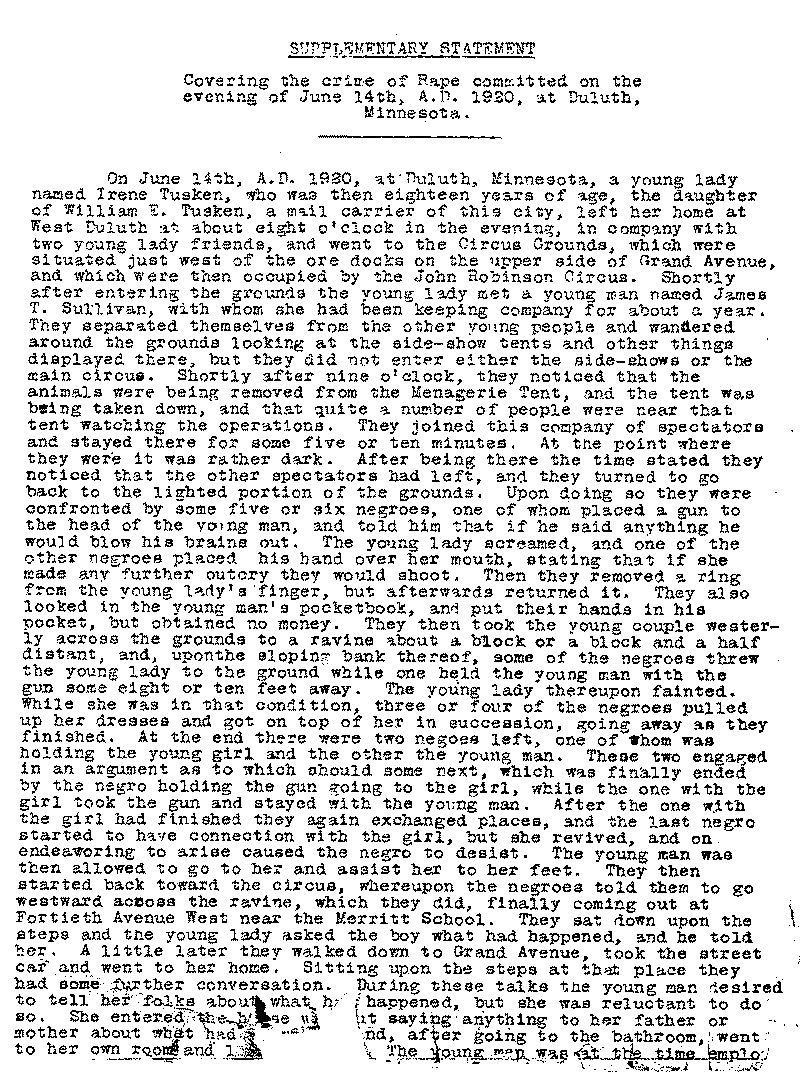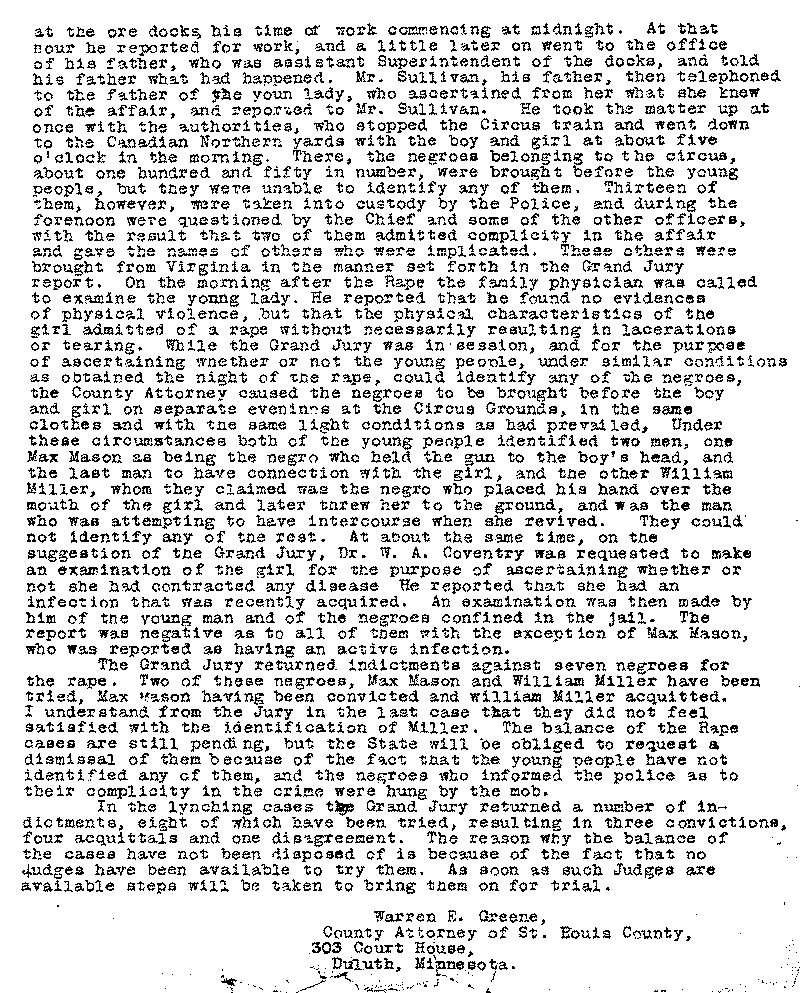Supplementary Statement submitted to J. A. A. Burnquist by Warren E. Greene.
Images


Image text
SUPPLEMENTARY STATEMENT
Covering the crime of Rape committed on the
evening of June
14th, A.D. 1920, at Duluth,
Minnesota.
On June l 4th, A. D. 1920, at Duluth, Minnesota, a
young lady named Irene Tusken, who was then eighteen years of age, the daughter
of William T. Tusken, a mail carrier of this city, left her home at West Duluth
at about eight o'clock in the evening, in company with two young lady friends,
and went to the Circus Grounds, which were situated just west of the ore docks
on the upper side of Grand Avenue, and which were then occupied by the John
Robinson Circus. Shortly after entering the grounds the young lady met a young
man named James T. Sullivan, with whom she had been keeping company for about a
year. They separated themselves from the other young people and wandered around
the grounds looking at the side-show tents and other things displayed there, but
they did not enter either the side-shows or the main circus. Shortly after nine
o'clock, they noticed. that the animals were being removed from the Menagerie
Tent, and the tent was being taken down, and that quite a number of people were
near that tent watching the operations. They joined this company of spectators
and stayed there for some five or ten minutes. At the point where they were it
was rather dark . After being there the time stated they noticed that the other
spectators had left, and they turned to go back to the lighted portion of the
grounds. Upon doing so they were confronted by some five or six negroes, one of
whom placed a gun to the head of the young man, and told him that if he said
anything he would blow his brains out. The young lady screamed, and one of the
other negroes placed his hand over her mouth, stating that if she made any
further outcry they would shoot. Then they removed a ring from the young lady's
finger, but afterwards returned it. They also looked in. the young man's
pocketbook, and put their hands in his pocket, but obtained no money. They then
took the young couple westerly across the grounds to a ravine about a block or a
block and a half distant, and, upon the sloping bank thereof, some of the
negroes threw the young lady to the ground while one held the young man with
the gun some eight or ten feet away. The young lady thereupon fainted. While she
was in that condition, three or four of the negroes pulled up her dresses and
got on top of her in succession, going away as they finished. At the end there
were two negroes left, one of whom was holding the young girl and the other the
young man. These two engaged in an argument as to which should some next, which
was finally ended by the negro holding the gun going to the girl, while the one
with the girl took the gun and stayed with the young man. After the one with the
girl had finished they again exchanged places, and the last Negro started to
have connection with the girl, but she revived, and on endeavoring to arise
caused the negro to desist. The young man was then allowed to go to her and
assist her to her feet. They then started back toward the circus, whereupon the
negroes told them to go westward across the ravine, which they did, finally
coming out at Fortieth Avenue West near the Merritt School. They sat down upon
the steps and the young lady asked the boy what had happened, and he told her. A
little later they walked down to Grand Avenue, took the street car and went to
her home. Sitting upon the steps at that place they had some further
conversation. During these talks the young man desired to tell her folks about
what had happened, but she was reluctant to do so . She entered the house
without saying anything to her father or mother about what had happened, after
going to the bathroom, went to her own room and l [page torn] The
young man was at the time employed
at the ore docks his time at work commencing at midnight. At that hour he reported for work; and a little later on went to the office of his father, who was assistant Superintendent of the docks, and told his father what had happened. Mr. Sullivan., his father, then telephoned to the father of the young lady, who ascertained from her what she knew of the affair, and reported to Mr. Sullivan. He took the matter up at once with the authorities, who stopped the Circus train and went down to the Canadian Northern yards with the boy and girl at about five o'clock in the morning. There, the negroes belonging to the circus, about one hundred and fifty in number, were brought before the young people, but they were unable to identify any of them. Thirteen of them, however, were taken into custody by the Police, and during the forenoon were questioned by the Chief and some of the other officers, with the result that two of them admitted complicity in the affair and gave the names of others who were implicated. These others were brought from Virginia in the manner set forth in the Grand Jury report. On the morning after the Rape the family physician was called to examine the young lady. He reported that he found no evidences of physical violence, but that the physical characteristics of the
girl admitted of a rape without necessarily resulting in lacerations or
tearing. While the Grand Jury vas in session, and for the purpose of
ascertaining whether or not the young people, under similar conditions as
obtained the night of the rape, could identify any of the negroes,
the County
Attorney caused the negroes to be brought before the boy and girl on separate
evenings at the Circus Grounds, in the same clothes and with the same light
conditions as had prevailed. Under these circumstances both of the young people
identified two men, one
Max Mason as being the negro who held the gun to the
boy's head, and the last man to have connection with the girl, and the other
William Miller, whom they claimed was the negro who placed his hand over the
mouth of the girl and later threw her to the ground, and was the man
who was
attempting to have intercourse when she revived. They could not identify any of
the rest. At about the same time, on the suggestion of the Grand Jury, Dr. W. A.
Coventry was requested to make an examination of the girl for the purpose of
ascertaining whether or
not she had contracted any disease. He reported that
she had an infection that was recently acquired. An examination was then made by
him of the young man and of the negroes confined in the. The report was negative
as to all of them with the exception of Max Mason,
who was reported as having
an active infection.
The Grand Jury returned indictments against seven
negroes for the rape. Two of these negroes, Max Mason and William Miller have
been tried, Max Mason having been convicted and William Miller acquitted. I
understand from the Jury in the last case that they did not feel satisfied with
the identification of Miller. The balance of the Rape cases are still pending,
but the State will be obliged to request a dismissal of them because of the fact
that the young people have not identified any of them, and the negroes who
informed the police as to their complicity in the crime ware hung by the
mob.
In the lynching cases the Grand Jury returned a number of indictments,
eight of which have been tried, resulting in three convictions, four acquittals
and one disagreement. The reason why the balance of the cases have not been
disposed of is because of the fact that no
judges have been available to try
them. As soon as such judges are available steps wily be taken to bring them on
for trial.
Warren E. Greene,
County Attorney of St. Louis County,
303 Court House, Duluth, Minnesota.

